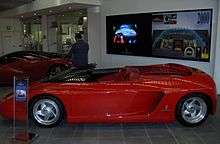Ferrari
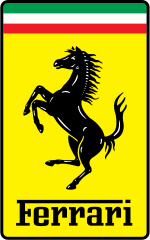 | |||||||
Native name | Ferrari N.V. | ||||||
|---|---|---|---|---|---|---|---|
| Public | |||||||
| Traded as |
| ||||||
| Industry | Automotive | ||||||
| Founded | 13 September 1939 in Modena, Italy (as Auto Avio Costruzioni)[1] | ||||||
| Founder | Enzo Ferrari | ||||||
| Headquarters |
| ||||||
Area served | Worldwide | ||||||
Key people |
| ||||||
| Products | Sports cars | ||||||
Production output |
| ||||||
| Revenue |
| ||||||
|
| |||||||
|
| |||||||
| Total assets |
| ||||||
| Total equity |
| ||||||
| Owners |
| ||||||
Number of employees | 3,336 (2017) | ||||||
| Subsidiaries |
Ferrari S.p.A. Scuderia Ferrari S.p.A. | ||||||
| Website | ferrari.com | ||||||
|
Footnotes / references [2] | |||||||
Ferrari N.V. (Italian: [ferˈrari]) is an Italian luxury sports car manufacturer based in Maranello. Founded by Enzo Ferrari in 1939 out of Alfa Romeo's race division as Auto Avio Costruzioni, the company built its first car in 1940. However, the company's inception as an auto manufacturer is usually recognized in 1947, when the first Ferrari-badged car was completed.
In 2014, Ferrari was rated the world's most powerful brand by Brand Finance.[3] In May 2012, the 1962 250 GTO became the most expensive car in history, selling in a private transaction for US$38.1 million to American communications magnate Craig McCaw.[4]
Fiat S.p.A. acquired 50% of Ferrari in 1969 and expanded its stake to 90% in 1988.[5] In October 2014 Fiat Chrysler Automobiles N.V. (FCA) announced its intentions to separate Ferrari S.p.A. from FCA; as of the announcement FCA owned 90% of Ferrari.[6][7][8] The separation began in October 2015 with a restructuring that established Ferrari N.V. (a company incorporated in the Netherlands) as the new holding company of the Ferrari group and the subsequent sale by FCA of 10% of the shares in an IPO and concurrent listing of common shares on the New York Stock Exchange.[9] Through the remaining steps of the separation, FCA's interest in Ferrari's business was distributed to shareholders of FCA, with 10% continuing to be owned by Piero Ferrari.[10] The spin-off was completed on 3 January 2016.[9]
Throughout its history, the company has been noted for its continued participation in racing, especially in Formula One, where it is the most successful racing team, holding the most constructors championships (16) and having produced the highest number of drivers' championship wins (15).[11] Ferrari road cars are generally seen as a symbol of speed, luxury and wealth.[12]
History
Enzo Ferrari was not initially interested in the idea of producing road cars when he formed Scuderia Ferrari in 1929, with headquarters in Modena. Scuderia Ferrari (pronounced [skudeˈriːa]) literally means "Ferrari Stable" and is usually used to mean "Team Ferrari." Ferrari bought, prepared, and fielded Alfa Romeo racing cars for gentleman drivers, functioning as the racing division of Alfa Romeo. In 1933, Alfa Romeo withdrew its in-house racing team and Scuderia Ferrari took over as its works team:[1] the Scuderia received Alfa's Grand Prix cars of the latest specifications and fielded many famous drivers such as Tazio Nuvolari and Achille Varzi. In 1938, Alfa Romeo brought its racing operation again in-house, forming Alfa Corse in Milano and hired Enzo Ferrari as manager of the new racing department; therefore the Scuderia Ferrari was disbanded.[1]
In September 1939, Ferrari left Alfa Romeo under the provision he would not use the Ferrari name in association with races or racing cars for at least four years.[1] A few days later he founded Auto Avio Costruzioni, headquartered in the facilities of the old Scuderia Ferrari.[1] The new company ostensibly produced machine tools and aircraft accessories. In 1940, Ferrari produced a race car – the Tipo 815, based on a Fiat platform. It was the first Ferrari car and debuted at the 1940 Mille Miglia, but due to World War II it saw little competition. In 1943, the Ferrari factory moved to Maranello, where it has remained ever since. The factory was bombed by the Allies and subsequently rebuilt including a works for road car production.

The first Ferrari-badged car was the 1947 125 S, powered by a 1.5 L V12 engine;[1] Enzo Ferrari reluctantly built and sold his automobiles to fund Scuderia Ferrari.[13]
The Scuderia Ferrari name was resurrected to denote the factory racing cars and distinguish them from those fielded by customer teams.
In 1960 the company was restructured as a public corporation under the name SEFAC S.p.A. (Società Esercizio Fabbriche Automobili e Corse).[14]
Early in 1969, Fiat took a 50% stake in Ferrari. An immediate result was an increase in available investment funds, and work started at once on a factory extension intended to transfer production from Fiat's Turin plant of the Ferrari engined Fiat Dino. New model investment further up in the Ferrari range also received a boost.
In 1988, Enzo Ferrari oversaw the launch of the Ferrari F40, the last new Ferrari launched before his death later that year. In 1989, the company was renamed Ferrari S.p.A.[14] From 2002 to 2004, Ferrari produced the Enzo, their fastest model at the time, which was introduced and named in honor of the company's founder, Enzo Ferrari. It was to be called the F60, continuing on from the F40 and F50, but Ferrari was so pleased with it, they called it the Enzo instead. It was initially offered to loyal and recurring customers, each of the 399 made (minus the 400th which was donated to the Vatican for charity) had a price tag of $650,000 apiece (equivalent to £400,900).
On 15 September 2012, 964 Ferrari cars (worth over $162 million- which is equivalent to £99,950,000) attended the Ferrari Driving Days event at Silverstone Circuit and paraded round the Silverstone Circuit setting a world record.[15]
Ferrari's former CEO and Chairman, Luca di Montezemolo, resigned from the company after 23 years, who was succeeded by Amedeo Felisa and finally on 3 May 2016 Amedeo resigned and was succeeded by Sergio Marchionne, CEO and Chairman of Fiat Chrysler Automobiles, Ferrari's parent company.[16] In July 2018, Marchionne was replaced by board member Louis Camilleri as CEO and by John Elkann as chairman.[17]
On 29 October 2014, the FCA group, resulting from the merger between manufacturers Fiat and Chrysler, announced the split of its luxury brand, Ferrari. The aim is to turn Ferrari into an independent brand which 10% of stake will be sold in an IPO in 2015.[18] Ferrari officially priced its initial public offering at $52 a share after the market close on 20 October 2015.[19]
Motorsport
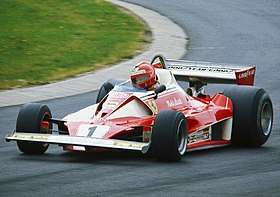
Since the company's beginnings, Ferrari has been involved in motorsport, competing in a range of categories including Formula One and sports car racing through its Scuderia Ferrari sporting division as well as supplying cars and engines to other teams and for one make race series.
The 1940 AAC 815 was the first racing car to be designed by Enzo Ferrari, although it was not badged as a Ferrari model.
Scuderia Ferrari
Scuderia Ferrari has participated in several classes of motorsport, though it is currently only officially involved in Formula One. It is the only team to have competed in the Formula One World Championship continuously since its inception in 1950. José Froilán González gave the team its first F1 victory at the 1951 British Grand Prix.
Alberto Ascari gave Ferrari its first Drivers Championship a year later. Ferrari is the oldest team in the championship, and the most successful: the team holds nearly every Formula One record. As of 2014, the team's records include 15 World Drivers Championship titles (1952, 1953, 1956, 1958, 1961, 1964, 1975, 1977, 1979, 2000, 2001, 2002, 2003, 2004 and 2007) 16 World Constructors Championship titles (1961, 1964, 1975, 1976, 1977, 1979, 1982, 1983, 1999, 2000, 2001, 2002, 2003, 2004, 2007 and 2008), 221 Grand Prix victories, 6736.27 points, 679 podium finishes, 207 pole positions, and 230 fastest laps in 890 Grands Prix contested. Of the 19 tracks used in 2014, 8 have lap records set by the F2004, with a further 3 set by the F2003-GA, F2008 and F10.
Ferrari drivers include: Tazio Nuvolari, José Froilán González, Juan Manuel Fangio, Alberto Ascari, Luigi Chinetti, Maurice Trintignant, Wolfgang von Trips, Phil Hill, Olivier Gendebien, Mike Hawthorn, Peter Collins, Giancarlo Baghetti, Ricardo Rodríguez, Chris Amon, John Surtees, Lorenzo Bandini, Ludovico Scarfiotti, Jacky Ickx, Mario Andretti, Clay Regazzoni, Niki Lauda, Carlos Reutemann, Jody Scheckter, Gilles Villeneuve, Didier Pironi, Patrick Tambay, René Arnoux, Michele Alboreto, Gerhard Berger, Nigel Mansell, Alain Prost, Jean Alesi, Michael Schumacher, Eddie Irvine, Rubens Barrichello, Felipe Massa, Kimi Räikkönen, Fernando Alonso, and Sebastian Vettel.
At the end of the 2006 season, the team courted controversy by continuing to allow Marlboro to sponsor them after they, along with the other F1 teams, made a promise to end sponsorship deals with tobacco manufacturers. A five-year deal was agreed and although this was not due to end until 2011, in April 2008 Marlboro dropped their on-car branding on Ferrari.
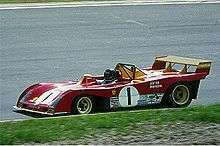
In addition to Formula One, Ferrari also entered cars in sportscar racing, the two programs existing in parallel for many years.
In 1949, Luigi Chinetti drove a 166 M to Ferrari's first win in motorsports, the 24 Hours of Le Mans. Ferrari went on to dominate the early years of the World Sportscar Championship which was created in 1953, winning the title seven out of its first nine years.
When the championship format changed in 1962, Ferrari earned titles in at least one class each year through to 1965 and then again in 1967. Ferrari would win one final title, the 1972 World Championship of Makes before Enzo decided to leave sports car racing after 1973 and allow Scuderia Ferrari to concentrate solely on Formula One.
During Ferrari's seasons of the World Sportscars Championship, they also gained more wins at the 24 Hours of Le Mans, with the factory team earning their first in 1954. Another win would come in 1958, followed by five consecutive wins from 1960 to 1964. Luigi Chinetti's North American Racing Team (NART) would take Ferrari's final victory at Le Mans in 1965.
Although Scuderia Ferrari no longer participated in sports cars after 1973, they have occasionally built various successful sports cars for privateers. These include the BB 512 LM in the 1970s, the 333 SP which won the IMSA GT Championship in the 1990s, and currently the 458 GT2 and GT3 which are currently winning championships in their respective classes.
Race cars for other teams
Throughout its history, Ferrari has supplied racing cars to other entrants, aside from its own works Scuderia Ferrari team.
In the 1950s and '60s, Ferrari supplied Formula One cars to a number of private entrants and other teams. One famous example was Tony Vandervell's team, which raced the Thinwall Special modified Ferraris before building their own Vanwall cars. The North American Racing Team's entries in the final three rounds of the 1969 season were the last occasions on which a team other than Scuderia Ferrari entered a World Championship Grand Prix with a Ferrari car.[20]
Ferrari supplied cars complete with V8 engines for the A1 Grand Prix series, from the 2008-09 season.[21] The car was designed by Rory Byrne and is styled to resemble the 2004 Ferrari Formula one car.
Ferrari currently runs a customer GT program for a racing version of its 458, and has done so for the 458's predecessors, dating back to the 355 in the late 1990s. Such private teams as the American Risi Competizione and Italian AF Corse teams have been very successful with Ferrari GT racers over the years. This car, made for endurance sportscar racing to be competed against such racing versions of the Audi R8, McLaren MP4-12C, and BMW Z4 (E89) has proven to be successful, but not as successful as its predecessor, the F430. The Ferrari Challenge is a one make racing series for the Ferrari 458. The FXX is not road legal, and is therefore only used for track events.
Road cars
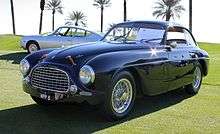
Ferrari's first vehicle was the 125 S sports/racing model. In 1949, the 166 Inter was introduced. The presentation of this car marked the company's first move into the grand touring market, which continues to make up the bulk of Ferrari sales to the present day.
Many early cars featured bodywork designed and customised by independent coachbuilders such as Pininfarina, Scaglietti, Zagato, Vignale and Bertone. Starting in the early 2010s with the LaFerrari, focus was shifted to what is now the standard, Ferrari relying on in-house design from the Centro Stile Ferrari.
The Dino was the first mid-engined Ferrari. This layout would go on to be used in most Ferraris of the 1980s and 1990s. The Dino was produced primarily with a V6 engine, however a V8 model was also produced. Current road cars typically use V8 or V12 engines, with V8 models making up well over half of the marque's total production. Historically, Ferrari has also produced flat 12 engines.
For a time, Ferrari built 2+2 versions of its mid-engined V8 cars. Although they looked quite different from their 2-seat counterparts, both the GT4 and Mondial were closely related to the 308 GTB.
The company has also produced several front-engined 2+2 cars, culminating in the current V12 model Lusso and V8 models Portofino and Lusso T. The California is credited with initiating the popular current model line of V8 front-engined 2+2 grand touring performance sports cars.
Ferrari entered the mid-engined 12-cylinder fray with the Berlinetta Boxer in 1973. The later Testarossa remains one of the most famous Ferraris.
Current models
| 488 GTB | 488 Spider | Portofino | 812 Superfast |
|---|---|---|---|
 |
 | ||
| F12tdf | GTC4Lusso / GTC4Lusso T | LaFerrari | LaFerrari Aperta |
|
|||
.jpg) |
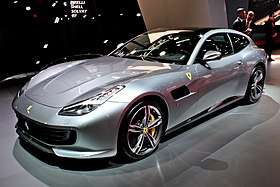 |
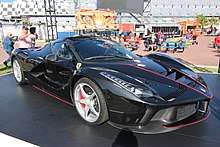 |
Customization
In the 1950s and 1960s, clients often personalized their vehicles as they came straight from the factory.[22] This philosophy added to the mystique of the brand. Every Ferrari that comes out of Maranello is built to an individual customer’s specification. In this sense, each vehicle is a unique result of a specific client’s desire.
Ferrari formalized this concept with its earlier Carrozzeria Scaglietti programme. The options offered here were more typical such as racing seats, rear view cameras and other special trim. In late 2011, Ferrari announced a significant update of this philosophy. The Tailor Made programme allows clients to work with designers in Maranello to make decisions at every step of the process. Through this program almost any trim, any exterior color or any interior material are possible. The program carries on the original tradition and emphasizes the idea of each car being unique. [23]
Supercars
The 1984 288 GTO may be considered the first in the line of Ferrari supercars. This pedigree extends through the Enzo Ferrari to the LaFerrari. In March 2018, at the 88th Geneva International Motor Show, Ferrari revealed its latest supercar, the 488 Pista.[24]
Concept cars and specials
Ferrari has produced a number of concept cars, such as the Mythos. While some of these were quite radical (such as the Modulo) and never intended for production, others such as the Mythos have shown styling elements which were later incorporated into production models.
The most recent concept car to be produced by Ferrari themselves was the 2010 Millechili.
A number of one-off special versions of Ferrari road cars have also been produced, commissioned to coachbuilders by wealthy owners. Recent examples include the P4/5[25] and the 412 Kappa.
Ferrari Special Projects
The Special Projects programme was launched in the late 2000s as Ferrari's ultimate in-house personalization service, enabling customers to own bespoke bodied one-offs based on modern Ferrari road cars.[26] Engineering and design is done by Ferrari, sometimes in cooperation with external design houses like Pininfarina or Fioravanti, and the vehicles receive full homologation to be road legal.[26]
The first car to be completed under this programme was the 2008 SP1, commissioned by a Japanese business executive, the second was the P540 Superfast Aperta, commissioned by an American collector.[26] The following is a list of Special Projects cars that have been made public:
| Name | Picture | Year | Based on | Commissioned by | Notes |
|---|---|---|---|---|---|
| SP1 |  |
2008 | F430[27] | Junichiro Hiramatsu[27] | Design by Leonardo Fioravanti.[27] |
| P540 Superfast Apert | 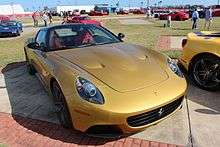 |
2009 | 599 GTB[28] | Edward Walson[28] | Inspired by a similarly gold-painted and open-topped one-off built by Carrozzeria Fantuzzi on a Ferrari 330 LMB chassis.[26][28] |
| Superamerica 45 | 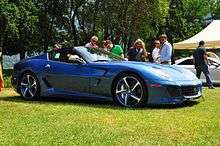 |
2011 | 599 GTB[29] | Peter Kalikow[29] | Rotating targa top;[29] design by Pininfarina |
| SP12 EC | 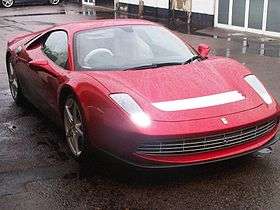 |
2012 | 458 Italia[30] | Eric Clapton[30] | Designed by Centro Stile Ferrari and Pininfarina, in hommage to the 512 BB.[30] |
| SP30 |  |
2013[31] | 599 GTO[31] | Cheerag Arya[31] | |
| SP FFX |  |
— | FF[32] | Shin Okamoto[32] | Design by Pininfarina[32] |
| Ferrari F12 TRS | .jpg) |
2014 | F12berlinetta[33] | — | Barchetta body, inspired by the Ferrari 250 Testa Rossa. Design by Centro Stile Ferrari.[33] |
| Ferrari SP America |  |
2014 | F12berlinetta | Danny Wegman[34] | |
| Ferrari 458 MM Speciale | .jpg) |
2016 | 458 Speciale[35] | — | Design by Centro Stile Ferrari.[35] |
| SP275 RW Competizione |  |
2016 | F12tdf | Rick Workman[36] | Inspired by the 1964 275 GTB/C Speciale. Design by Pininfarina in collaboration with Centro Stile Ferrari.[37] |
| Ferrari J50 |  |
2017 | 488 Spider | — | |
| SP38 |  |
2018 | 488 GTB | — | Inspired by the F40 and 308. [38] |
Bio-fuel and hybrid cars
An F430 Spider that runs on ethanol was displayed at the 2008 Detroit Auto Show. At the 2010 Geneva Motor Show, Ferrari unveiled a hybrid version of their flagship 599. Called the "HY-KERS Concept", Ferrari's hybrid system adds more than 100 horsepower on top of the 599 Fiorano's 612 HP.[39] Also in mid-2014, the flagship LaFerrari was put into production.
Naming conventions
Until the early 1990s, Ferrari followed a three-number naming scheme based on engine displacement:
- V6 and V8 models used the total displacement (in decilitres) for the first two digits and the number of cylinders as the third. Thus, the 206 was a 2.0 L V6 powered vehicle, while the 348 used a 3.4 L V8, although, for the F355, the last digit refers to 5 valves per cylinder. Upon introduction of the 360 Modena, the digits for V8 models (which now carried a name as well as a number) refer only to total engine displacement. The numerical indication aspect of this name carried on to the F430; the F430's replacement, the 458 Italia, uses the same naming as the 206 and 348. The 488 uses the system formerly used by the V12 cars.
- V12 models used the displacement (in cubic centimetres) of one cylinder. Therefore, the famed 365 Daytona had a 4,390 cc (268 cu in) V12. However, some newer V12-engined Ferraris, such as the 599, have three-number designations that refer only to total engine displacement or boxer-style designations such as the [nominally] six-litre, V12 612.
- Boxer 12 models used the displacement in litres for the first digit and the number of cylinders for the next two digits. Therefore, the BB 512 was five litre flat 12 (a Berlinetta Boxer, in this case). However, the original Berlinetta Boxer was the 365 GT4 BB, which was named in a similar manner to the V12 models.
- Flagship models (aka "halo cars") use the letter F followed by the anniversary in years, such as the F40 and F50. The Enzo skipped this rule, although the F60 name was applied to a Ferrari Formula One car and is sometimes attached to the Enzo.
- Some models, such as the 1980 Mondial and the 1984 Testarossa did not follow a three-number naming scheme.

Most Ferraris were also given designations referring to their body style. In general, the following conventions were used:
- M ("Modificata"), placed at the end of a model's number, denotes a modified version of its predecessor and not a complete evolution (see F512 M and 575 M Maranello).
- GTB ("Gran Turismo Berlinetta") models are closed Berlinettas, or coupés.
- GTS ("Gran Turismo Spider") in older models, are open Spiders, or convertibles (see 365 GTS/4); however, in more recent models, this suffix is used for targa top models (see Dino 246 GTS, and F355 GTS; the exception being the 348 TS, which is the only targa named differently). The convertible models now use the suffix "Spider" (spelt "i") (see F355 Spider, and 360 Spider).
- GTO ("Gran Turismo Omologata"), placed at the end of a model's number, denotes a modified version of its predecessor. They designate a model which has been designed and improved for racetrack use while still being street legal. Only three models bear those three letters: the 250 GTO of 1962, the 288 GTO of 1984, and the 599 GTO of 2010.
This naming system can be confusing, as some entirely different vehicles used the same engine type and body style. Many Ferraris also had other names affixed (like Daytona) to identify them further. Many such names are actually not official factory names. The Daytona name commemorates Ferrari's triple success in the February 1967 24 Hours of Daytona with the 330 P4.[40] Only in the 1973 Daytona 24 Hours, a 365 GTB/4 run by NART (who raced Ferraris in America) ran second, behind a Porsche 911.[41]
The various Dino models were named for Enzo's son, Dino Ferrari, and were marketed as Dinos by Ferrari and sold at Ferrari dealers—for all intents and purposes they are Ferraris.
In the mid-1990s, Ferrari added the letter "F" to the beginning of all models (a practice abandoned after the F512 M and F355, but adopted again with the F430, but not with its successor, the Ferrari 458 ).
Identity
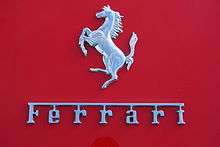
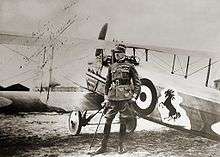
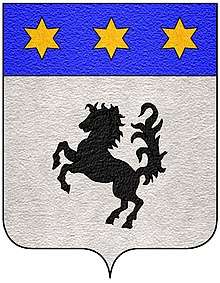
The famous symbol of the Ferrari race team is the Cavallino Rampante ("prancing horse") black prancing stallion on a yellow shield, usually with the letters S F (for Scuderia Ferrari), with three stripes of green, white and red (the Italian national colors) at the top. The road cars have a rectangular badge on the hood (see picture at top of page), and, optionally, the shield-shaped race logo on the sides of both front wings, close to the door.
On 17 June 1923, Enzo Ferrari won a race at the Savio track in Ravenna where he met the Countess Paolina, mother of Count Francesco Baracca, an ace of the Italian air force and national hero of World War I, who used to paint a horse on the side of his planes. The Countess asked Enzo to use this horse on his cars, suggesting that it would bring him good luck. The original "prancing horse" on Baracca's airplane was painted in red on a white cloud-like shape, but Ferrari chose to have the horse in black (as it had been painted as a sign of grief on Baracca's squadron planes after the pilot was killed in action) and he added a canary yellow background as this is the color of the city of Modena, his birthplace. The Ferrari horse was, from the very beginning, markedly different from the Baracca horse in most details, the most noticeable being the tail that in the original Baracca version was pointing downward.
Ferrari has used the cavallino rampante on official company stationery since 1929. Since the Spa 24 Hours of 9 July 1932, the cavallino rampante has been used on Alfa Romeos raced by Scuderia Ferrari.
The motif of a prancing horse is old, it can be found on ancient coins. A similar black horse on a yellow shield is the Coat of Arms of the German city of Stuttgart, home of Mercedes-Benz and the design bureau of Porsche, both being main competitors of Alfa and Ferrari in the 1930s. The city's name derives from Stutengarten, an ancient form of the German word Gestüt, which translates into English as stud farm and into Italian as scuderia. Porsche also includes the Stuttgart sign in its corporate logo, centred in the emblem of the state of Württemberg. Stuttgart's Rössle has both rear legs firmly planted on the soil, like Baracca's horse, but unlike Ferrari's cavallino.
Fabio Taglioni used the cavallino rampante on his Ducati motorbikes, as Taglioni was born at Lugo di Romagna like Baracca, and his father too was a military pilot during WWI (although not part of Baracca's squadron, as is sometimes mistakenly reported). As Ferrari's fame grew, Ducati abandoned the horse- perhaps the result of a private agreement between the two companies.

The cavallino rampante is the visual symbol of Ferrari. Cavallino Magazine uses the name, but not the logo. Other companies use similar logos: Avanti, an Austrian company operating over 100 filling stations, uses a prancing horse logo which is nearly identical to Ferrari's, as does Iron Horse Bicycles and Norfolk Southern Railway.
Colour
Since the 1920s, Italian race cars of Alfa Romeo, Maserati and later Ferrari and Abarth were (and often still are) painted in "race red" (Rosso Corsa). This was the customary national racing color of Italy, as recommended between the World Wars by the organizations that later would become the FIA. It refers to the nationality of the competing team, not that of the car manufacturer or driver. In that scheme, French-entered cars such as Bugatti were blue, German such as Auto Union and Mercedes white (since 1934 also bare sheet metal silver), and British green such as the mid-1960s Lotus and BRM, for instance.
Ferrari won the 1964 World championship with John Surtees by competing the last two races in North America with cars painted in the US-American race colors white and blue, as these were not entered by the Italian factory themselves, but by the U.S.-based North American Racing Team (NART) team. This was done as a protest concerning arguments between Ferrari and the Italian Racing Authorities regarding the homologation of a new mid-engined Ferrari race car.
Corporate affairs
In 1963, Enzo Ferrari was approached by the Ford Motor Company about a possible buy out.[42] Ford audited Ferrari's assets but legal negotiations and talks were unilaterally cut off by Ferrari when he realized that the deal offered by Ford would not enable him to stay at the helm of the company racing program. Henry Ford II consequently directed his racing division to negotiate with Lotus, Lola, and Cooper to build a car capable of beating Ferrari on the world endurance circuit, eventually resulting in the production of the Ford GT40 in 1964.
As the Ford deal fell through, FIAT approached Ferrari with a more flexible proposal and purchased controlling interests in the company in 1969. Enzo Ferrari retained a 10% share, which is currently owned by his son Piero Lardi Ferrari.
Ferrari has an internally managed merchandising line that licenses many products bearing the Ferrari brand, including eyewear, pens, pencils, electronic goods, perfume, cologne, clothing, high-tech bicycles, watches, cell phones and laptop computers.
Ferrari also runs a museum, the Museo Ferrari in Maranello, which displays road and race cars and other items from the company's history.
Formula Uomo programme
In 1997 Ferrari launched a long term master planned effort to improve overall corporate efficiency, production and employee happiness. The program was called Formula Uomo and became a case study in social sustainability.[43] It took over ten years to fully implement and included over €200 million (2008) in investment.[44]
Technical partnerships
Ferrari has had a long-standing relationship with Shell Oil. It is a technical partnership with Ferrari and Ducati to test as well as supply fuel and oils to the Formula One, MotoGP and World Superbike racing teams. For example, the Shell V-Power premium gasoline fuel has been developed with the many years of technical expertise between Shell and Ferrari.[45]
Ferrari have had agreements to supply Formula One engines to a number of other teams over the years, and currently supply Sauber F1 Team, and Haas F1 Team.
Sales history
As of 2018, the estimated total of Ferrari built and sold cars in whole company history was about 190,000.[46]
| Year | Sales to end customers (number of type-approved vehicles) | |||||||||||||||||||||||||||||||||||||||||||||||||||||||||||||||||||||||||||||||||||||||||||||||||||
|---|---|---|---|---|---|---|---|---|---|---|---|---|---|---|---|---|---|---|---|---|---|---|---|---|---|---|---|---|---|---|---|---|---|---|---|---|---|---|---|---|---|---|---|---|---|---|---|---|---|---|---|---|---|---|---|---|---|---|---|---|---|---|---|---|---|---|---|---|---|---|---|---|---|---|---|---|---|---|---|---|---|---|---|---|---|---|---|---|---|---|---|---|---|---|---|---|---|---|---|---|
| 1 | 2 | 3 | 4 | 5 | 6 | 7 | 8 | 9 | 10 | |||||||||||||||||||||||||||||||||||||||||||||||||||||||||||||||||||||||||||||||||||||||||||
| 1977[47] | 1,798* | |||||||||||||||||||||||||||||||||||||||||||||||||||||||||||||||||||||||||||||||||||||||||||||||||||
| 1978[47] | 1,939* | |||||||||||||||||||||||||||||||||||||||||||||||||||||||||||||||||||||||||||||||||||||||||||||||||||
| 1979[47] | 2,221* | |||||||||||||||||||||||||||||||||||||||||||||||||||||||||||||||||||||||||||||||||||||||||||||||||||
| 1980[47] | 2,470* | |||||||||||||||||||||||||||||||||||||||||||||||||||||||||||||||||||||||||||||||||||||||||||||||||||
| 1981[47] | 2,565* | |||||||||||||||||||||||||||||||||||||||||||||||||||||||||||||||||||||||||||||||||||||||||||||||||||
| 1982[47] | 2,209* | |||||||||||||||||||||||||||||||||||||||||||||||||||||||||||||||||||||||||||||||||||||||||||||||||||
| 1983[48] | 2,366* | |||||||||||||||||||||||||||||||||||||||||||||||||||||||||||||||||||||||||||||||||||||||||||||||||||
| 1984[49] | 2,856* | |||||||||||||||||||||||||||||||||||||||||||||||||||||||||||||||||||||||||||||||||||||||||||||||||||
| 1985[47] | 3,051 | |||||||||||||||||||||||||||||||||||||||||||||||||||||||||||||||||||||||||||||||||||||||||||||||||||
| 1986[47] | 3,663 | |||||||||||||||||||||||||||||||||||||||||||||||||||||||||||||||||||||||||||||||||||||||||||||||||||
| 1987[50] | 3,942 | |||||||||||||||||||||||||||||||||||||||||||||||||||||||||||||||||||||||||||||||||||||||||||||||||||
| 1988[51] | 3,821 | |||||||||||||||||||||||||||||||||||||||||||||||||||||||||||||||||||||||||||||||||||||||||||||||||||
| 1989[52] | 3,996 | |||||||||||||||||||||||||||||||||||||||||||||||||||||||||||||||||||||||||||||||||||||||||||||||||||
| 1990[53] | 4,309 | |||||||||||||||||||||||||||||||||||||||||||||||||||||||||||||||||||||||||||||||||||||||||||||||||||
| 1991[53] | 4,561 | |||||||||||||||||||||||||||||||||||||||||||||||||||||||||||||||||||||||||||||||||||||||||||||||||||
| 1992[53] | 3,470 | |||||||||||||||||||||||||||||||||||||||||||||||||||||||||||||||||||||||||||||||||||||||||||||||||||
| 1993[53] | 2,289 | |||||||||||||||||||||||||||||||||||||||||||||||||||||||||||||||||||||||||||||||||||||||||||||||||||
| 1994[53] | 2,792 | |||||||||||||||||||||||||||||||||||||||||||||||||||||||||||||||||||||||||||||||||||||||||||||||||||
| 1995[53] | 3,307 | |||||||||||||||||||||||||||||||||||||||||||||||||||||||||||||||||||||||||||||||||||||||||||||||||||
| 1996[54] | 3,316 | |||||||||||||||||||||||||||||||||||||||||||||||||||||||||||||||||||||||||||||||||||||||||||||||||||
| 1997[55] | 3,581 | |||||||||||||||||||||||||||||||||||||||||||||||||||||||||||||||||||||||||||||||||||||||||||||||||||
| 1998[56] | 3,637 | |||||||||||||||||||||||||||||||||||||||||||||||||||||||||||||||||||||||||||||||||||||||||||||||||||
| 1999[57] | 3,775 | |||||||||||||||||||||||||||||||||||||||||||||||||||||||||||||||||||||||||||||||||||||||||||||||||||
| 2000[58] | 4,070 | |||||||||||||||||||||||||||||||||||||||||||||||||||||||||||||||||||||||||||||||||||||||||||||||||||
| 2001[59] | 4,289 | |||||||||||||||||||||||||||||||||||||||||||||||||||||||||||||||||||||||||||||||||||||||||||||||||||
| 2002[60] | 4,236 | |||||||||||||||||||||||||||||||||||||||||||||||||||||||||||||||||||||||||||||||||||||||||||||||||||
| 2003[61] | 4,238 | |||||||||||||||||||||||||||||||||||||||||||||||||||||||||||||||||||||||||||||||||||||||||||||||||||
| 2004[62] | 4,975 | |||||||||||||||||||||||||||||||||||||||||||||||||||||||||||||||||||||||||||||||||||||||||||||||||||
| 2005[63] | 5,409 | |||||||||||||||||||||||||||||||||||||||||||||||||||||||||||||||||||||||||||||||||||||||||||||||||||
| 2006[64] | 5,671 | |||||||||||||||||||||||||||||||||||||||||||||||||||||||||||||||||||||||||||||||||||||||||||||||||||
| 2007[65] | 6,465 | |||||||||||||||||||||||||||||||||||||||||||||||||||||||||||||||||||||||||||||||||||||||||||||||||||
| 2008[66] | 6,587 | |||||||||||||||||||||||||||||||||||||||||||||||||||||||||||||||||||||||||||||||||||||||||||||||||||
| 2009[67] | 6,250 | |||||||||||||||||||||||||||||||||||||||||||||||||||||||||||||||||||||||||||||||||||||||||||||||||||
| 2010[68] | 6,461 | |||||||||||||||||||||||||||||||||||||||||||||||||||||||||||||||||||||||||||||||||||||||||||||||||||
| 2011[69] | 7,001 | |||||||||||||||||||||||||||||||||||||||||||||||||||||||||||||||||||||||||||||||||||||||||||||||||||
| 2012[70] | 7,318 | |||||||||||||||||||||||||||||||||||||||||||||||||||||||||||||||||||||||||||||||||||||||||||||||||||
| 2013[71] | 6,922 | |||||||||||||||||||||||||||||||||||||||||||||||||||||||||||||||||||||||||||||||||||||||||||||||||||
| 2014[72] | 7,255† | |||||||||||||||||||||||||||||||||||||||||||||||||||||||||||||||||||||||||||||||||||||||||||||||||||
| 2015[73] | 7,664† | |||||||||||||||||||||||||||||||||||||||||||||||||||||||||||||||||||||||||||||||||||||||||||||||||||
| 2016[74] | 8,014† | |||||||||||||||||||||||||||||||||||||||||||||||||||||||||||||||||||||||||||||||||||||||||||||||||||
| 2017[75] | 8,398† | |||||||||||||||||||||||||||||||||||||||||||||||||||||||||||||||||||||||||||||||||||||||||||||||||||
- * Figure refers to units produced rather than to units sold.
- † Figure refers to units shipped rather than to units sold.
Stores
Approximately thirty Ferrari boutiques exist worldwide, with two owned by Ferrari and the rest operating as franchises. The stores sell branded clothes, accessories and racing memorabilia. Clothing includes upscale and lower priced collections for men, women, and children.
Some stores include race car simulation games for entertainment.[76]
See also
Notes
- 1 2 3 4 5 6 "History of Enzo Ferrari". auto.ferrari.com. Retrieved 31 May 2016.
- ↑ "2016 Annual Report" (PDF). Ferrari. 1 April 2017. Retrieved 8 April 2017.
- ↑ Haigh, Robert (18 February 2014). "Ferrari – The World's Most Powerful Brand". Brand Finance. Retrieved 9 February 2015.
- ↑ Reyburn, Scott (1 June 2012). "Ferrari GTO Becomes Most Expensive Car at $35 Million". bloomberg.com. Retrieved 3 June 2012.
- ↑ "Fiat Raises Stake In Ferrari to 90%". The New York Times Company. 8 September 1988. Retrieved 10 April 2014.
- ↑ "Fiat 2013 Annual Report" (PDF). Fiat S.p.A. Retrieved 13 August 2014.
- ↑ "FCA Announces Board Intention to Spin Off Ferrari S.p.A" (PDF). Fiat S.p.A. Retrieved 28 October 2014.
- ↑ Sylvers, Eric (3 March 2015). "Fiat Chrysler May Sell More of Ferrari in IPO Sale". The Wall Street Journal. Retrieved 31 May 2015.
- 1 2 "Questions and answers regarding the Ferrari spin-off". Ferrari. Retrieved 7 January 2016.
- ↑ Visnic, Bill (23 July 2015). "Wall Street, Buckle Up! Ferrari Officially Files For IPO". The Wall Street Journal. Retrieved 24 July 2015.
- ↑ "Ferrari". www.wise-motorist.com. Archived from the original on 8 August 2016.
- ↑ "Luxury supercars". theaustralian.com.au. Retrieved 31 May 2016.
- ↑ "History of Ferrari In DK Engineering". 14 September 2010. Retrieved 29 September 2018.
- 1 2 "Ferrari S.p.A. History". Funding Universe. Retrieved 10 April 2014.
- ↑ "Felipe Massa and Marc Gene lead a record breaking parade of Ferraris at Silverstone". Skidmark. 15 September 2012. Retrieved 18 September 2012.
- ↑ "Ferrari CEO Quits In A Huff, Says Company Is Now 'American'".
- ↑ Editorial, Reuters. "Ferrari picks Louis Camilleri as CEO, Elkann as chairman".
- ↑ Ferrari quitte Fiat et rentre dans le circuit boursier, le Monde, 30 October 2014
- ↑ "Ferrari IPO prices at $52/share, within range". CNBC. Retrieved 21 October 2015.
- ↑ Hayhoe, David & Holland, David (2006). Grand Prix Data Book (4th edition). Haynes, Sparkford, UK. ISBN 978-1-84425-223-7
- ↑ "Ferrari's A1GP Deal". Yahoo Sport. 11 October 2007. Retrieved 24 March 2008.
- ↑ Lingeman, Jake. "Ferrari-offers-tailor-made-program". Autoweek. Retrieved 2018-08-12.
- ↑ Lingeman, Jake. "Ferrari-offers-tailor-made-program". Autoweek. Retrieved 2018-08-12.
- ↑ Raman, Rahul. "Ferrari 488 Pista Debuts in Geneva". The Drive. Retrieved 2018-03-14.
- ↑ September 2006 BY TED WEST. "Pininfarina Ferrari P4/5 – Feature – Car and Driver". Caranddriver.com. Retrieved 22 June 2014.
- 1 2 3 4 Neff, John (11 December 2009). "Ferrari P540 Superfast Aperta revealed, second from Special Projects program". autoblog.com. Retrieved 14 December 2014.
- 1 2 3 "Ferrari SP1". carbodydesign.com. 12 November 2008. Retrieved 13 December 2014.
- 1 2 3 Gluckman, David (11 December 2009). "Ferrari P540 Superfast Aperta: A One-Off Based On a One-Off". caranddriver.com. Retrieved 13 December 2014.
- 1 2 3 Kable, Greg (18 May 2011). "Ferrari Superamerica 45: One-off 599 created for wealthy American customer". autoweek.com. Retrieved 13 December 2014.
- 1 2 3 Lingeman, Jake (6 November 2012). "Ferrari and Pininfarina finish Clapton's customized 512BB homage". autoweek.com. Retrieved 13 December 2014.
- 1 2 3 "Ferrari SP Arya one-off in the works". carbodydesign.com. 28 August 2012. Retrieved 13 December 2014.
- 1 2 3 "Japan Gathering Features Two One-Off Models". cavallino.com. 1 April 2014. Archived from the original on 14 December 2014. Retrieved 13 December 2014.
- 1 2 Joseph, Noah (23 June 2014). "Ferrari reveals one-off F12 TRS at Sicily cavalcade homage". autoblog.com. Retrieved 13 December 2014.
- ↑ Anderson, Brad (24 September 2014). "One-off 2015 Ferrari F12 SP America snapped in public". gtspirit.com. Retrieved 13 December 2016.
- 1 2 Migliore, Greg (31 May 2016). "Ferrari reveals extra 'speciale' 458". autoblog.com. Retrieved 1 September 2016.
- ↑ "Full details on the one-off SP 275 RW Competizione". Motor Authority. Retrieved 2018-04-06.
- ↑ "Ferrari reveals its latest bespoke one-off: the SP 275 rw competizione - Ferrari.com". Ferrari GT - en-US. Retrieved 2018-04-06.
- ↑ "Surprise! The Ferrari SP38 is Maranello's latest one-off". www.topgear.com. Retrieved 2018-05-25.
- ↑ "The Ferrari HY-KERS Bows at Geneva". Automoblog.net. Retrieved 31 May 2016.
- ↑ "World Championship 1967". Wspr-racing.com. Archived from the original on 14 May 2011. Retrieved 26 September 2010.
- ↑ "World Championship 1973". Wspr-racing.com. Archived from the original on 14 May 2011. Retrieved 26 September 2010.
- ↑ "Ford GT". rmauctions.com.com.
- ↑ "Wellbeing Programme Ferrari Formula Uomo". Europa OSHA Case Studies. Europe. Retrieved 2018-07-13.
- ↑ "Ferrari California Begins Production on New Line". worldcarfans.com. 2008-06-26. Retrieved 2018-07-14.
- ↑ "Ferrari and Shell V-Power". Shell Canada. 15 January 2009. Archived from the original on 17 August 2009. Retrieved 20 January 2009.
- ↑ "Crunching Ferrari's Global Numbers". Ferraris-online.com. Retrieved 22 June 2014.
- 1 2 3 4 5 6 7 8 Fenu, Michele (16 January 1987), "Ferrari, un anno magico—Dieci anni di produzione", La Stampa (in Italian), p. 17, retrieved 13 February 2016
- ↑ "Azienda senza crisi", La Stampa (in Italian), p. 15, 7 September 1984, retrieved 13 February 2016
- ↑ "Ferrari un '85 record", La Stampa (in Italian), p. 15, 25 January 1985, retrieved 13 February 2016
- ↑ Rogliatti, Gianni (13 May 1988), "Ferrari "F40", si guida come un giocattolo", La Stampa (in Italian), p. 21, retrieved 13 February 2016
- ↑ Rogliatti, Gianni (13 May 1988), "Ferrari "F40", si guida come un giocattolo", La Stampa (in Italian), p. 21, retrieved 13 February 2016
- ↑ Rogliatti, Gianni (13 May 1988), "Ferrari "F40", si guida come un giocattolo", La Stampa (in Italian), p. 21, retrieved 13 February 2016
- 1 2 3 4 5 6 The Official Ferrari Opus. Opus. 2011. ISBN 978-1-905794-34-8.
- ↑ "Il fatturato Ferrari vola a mille miliardi", La Repubblica (in Italian), 16 May 1998, retrieved 11 September 2015
- ↑ "Il fatturato Ferrari vola a mille miliardi", La Repubblica (in Italian), 16 May 1998, retrieved 11 September 2015
- ↑ Fiat Group 1999 Annual Report (PDF)
- ↑ Fiat Group 1999 Annual Report (PDF)
- ↑ Fiat Group 2000 Annual Report (PDF)
- ↑ Fiat Group 2001 Annual Report (PDF)
- ↑ Fiat Group 2002 Annual Report (PDF)
- ↑ Fiat Group 2003 Annual Report (PDF)
- ↑ Fiat Group 2004 Annual Report (PDF)
- ↑ Fiat Group 2005 Annual Report (PDF)
- ↑ Fiat Group 2006 Annual Report (PDF)
- ↑ Fiat Group 2007 Annual Report (PDF)
- ↑ Fiat Group 2008 Annual Report (PDF)
- ↑ Fiat Group 2009 Annual Report (PDF)
- ↑ Fiat Group 2010 Annual Report (PDF)
- ↑ Fiat Group 2011 Annual Report (PDF)
- ↑ Fiat Group 2012 Annual Report (PDF)
- ↑ Holloway, Hilton. "Ferrari profits rise despite fewer sales in 2013". Autocar.co.uk. Retrieved 2 June 2015.
- ↑ FCA Full Year 2014 results (PDF), Fiat Chrysler Automobiles, 28 January 2015, p. 6, retrieved 11 March 2015
- ↑ Ferrari FY 2015 Results (PDF), Ferrari N.V., 2 February 2016, p. 20, retrieved 3 February 2016
- ↑ Ferrari Full Year 2016 Results (PDF), Ferrari N.V., 2 February 2016, p. 3, retrieved 7 February 2017
- ↑ Ferrari Full Year 2017 Results (PDF), Ferrari N.V., 2 February 2017, p. 3, retrieved 16 February 2018
- ↑ Martens, Cynthia (16 March 2015). "Ferrari Opens New Flagship Store". WWD. Retrieved 3 February 2017.
References
- Eric Gustafson, "Cavallino Rampante", Sports Car International (Oct/Nov 2000): 94.
- Adler, Dennis, Ferrari: The Road from Maranello. Random House, 2006. ISBN 978-1-4000-6463-2.
External links
Ferrari road car timeline, 1947–1969 — next » | |||||||||||||||||||||||
|---|---|---|---|---|---|---|---|---|---|---|---|---|---|---|---|---|---|---|---|---|---|---|---|
| Type | 1940s | 1950s | 1960s | ||||||||||||||||||||
| 7 | 8 | 9 | 0 | 1 | 2 | 3 | 4 | 5 | 6 | 7 | 8 | 9 | 0 | 1 | 2 | 3 | 4 | 5 | 6 | 7 | 8 | 9 | |
| Sports | 340 MM | 375 MM | |||||||||||||||||||||
| 125 S | 166 S/ |
195 S | 212 Export | 225 S | 250 MM | 250 Monza | 250 LM | ||||||||||||||||
| 159 S | 250 S | 250 Export | 250 GTO | ||||||||||||||||||||
| Berlinetta | 250 GT "Tour de France" | 250 GT SWB | 250 GT Lusso | 275 GTB | 275 GTB/4 | 365 | |||||||||||||||||
| Coupé | 166 Inter | 195 Inter | 212 Inter | 250 Europa | 250 GT Europa | 250 GT Boano | 250 GT Ellena | 250 GT Coupé Pininfarina | 330 GTC | 365 GTC | |||||||||||||
| 2+2 | 250 GT/E | 330 GT 2+2 | 365 GT 2+2 | ||||||||||||||||||||
| Spider | 250 GT Cabriolet | 275 GTS | 330 GTS | 365 GTS | |||||||||||||||||||
| 250 GT California Spyder | |||||||||||||||||||||||
| America | 340/342 America | 375 America | 410 Superamerica | 400 Superamerica | 500 Superfast | 365 California | |||||||||||||||||
« previous — Ferrari road car timeline, 1960s–1990s — next » | |||||||||||||||||||||||||||||||||||||||||
|---|---|---|---|---|---|---|---|---|---|---|---|---|---|---|---|---|---|---|---|---|---|---|---|---|---|---|---|---|---|---|---|---|---|---|---|---|---|---|---|---|---|
| Type | 1960s | 1970s | 1980s | 1990s | |||||||||||||||||||||||||||||||||||||
| 0 | 1 | 2 | 3 | 4 | 5 | 6 | 7 | 8 | 9 | 0 | 1 | 2 | 3 | 4 | 5 | 6 | 7 | 8 | 9 | 0 | 1 | 2 | 3 | 4 | 5 | 6 | 7 | 8 | 9 | 0 | 1 | 2 | 3 | 4 | 5 | 6 | 7 | 8 | 9 | ||
| 8 cylinder | Mid-engine berlinetta | 308 | 308 i | 308 QV | 328 | 348 | 360 | ||||||||||||||||||||||||||||||||||
| 208 | 208 Turbo | GTB/GTS Turbo | F355 | ||||||||||||||||||||||||||||||||||||||
| Mid-engine 2+2 | 308 GT4 | Mondial 8 | Mondial QV | Mondial 3.2 | Mondial t | ||||||||||||||||||||||||||||||||||||
| 208 GT4 | |||||||||||||||||||||||||||||||||||||||||
| 12 cylinder | Boxer berlinetta | 365 BB | 512 BB | 512i BB | Testarossa (F110) | 512TR | F512 M | ||||||||||||||||||||||||||||||||||
| Grand tourer | 250 | 275 | 365 GTB/4 "Daytona" |
550 Maranello | |||||||||||||||||||||||||||||||||||||
| America | 330 | 365 | |||||||||||||||||||||||||||||||||||||||
| 2+2 coupé | 250 GT/E | 330 GT 2+2 | 365 GT 2+2 | 365 GTC/4 |
365 GT4 2+2 | 400 | 400 i | 412 | 456 | 456M | |||||||||||||||||||||||||||||||
| Supercar | 250 GTO | 250 LM | 288 GTO |
F40 | F50 | ||||||||||||||||||||||||||||||||||||
| Sold under the Dino marque until 1976; see also Dino car timeline | |||||||||||||||||||||||||||||||||||||||||
« previous — Ferrari road car timeline, 1996–present | ||||||||||||||||||||||||
|---|---|---|---|---|---|---|---|---|---|---|---|---|---|---|---|---|---|---|---|---|---|---|---|---|
| Type | 1990s | 2000s | 2010s | |||||||||||||||||||||
| 6 | 7 | 8 | 9 | 0 | 1 | 2 | 3 | 4 | 5 | 6 | 7 | 8 | 9 | 0 | 1 | 2 | 3 | 4 | 5 | 6 | 7 | 8 | ||
| V8 | Rear mid-engine sports car |
360 | 458 | |||||||||||||||||||||
| Challenge Stradale | 430 Scuderia | 458 Speciale | 488 Pista | |||||||||||||||||||||
| F355 | F430 | 488 | ||||||||||||||||||||||
| Convertible | California | California T | Portofino | |||||||||||||||||||||
| 2+2 grand tourer | GTC4Lusso T | |||||||||||||||||||||||
| V12 | Grand tourer | 550 Maranello | 575M Maranello | 599 GTB Fiorano | F12berlinetta | 812 Superfast | ||||||||||||||||||
| 550 Barchetta | Superamerica | 599 SA Aperta/599 GTO | F60 America/F12tdf | |||||||||||||||||||||
| 2+2 grand tourer | 456 | 456 M | 612 Scaglietti | FF | GTC4Lusso | |||||||||||||||||||
| Supercar | F50 | Enzo | LaFerrari | LaFerrari Aperta | ||||||||||||||||||||
| XX Programmes | FXX | 599XX | 599XX Evoluzione | FXX K | FXX K Evo | |||||||||||||||||||
Coordinates: 44°31′57″N 10°51′51″E / 44.532447°N 10.864137°E
_(cropped).jpg)
